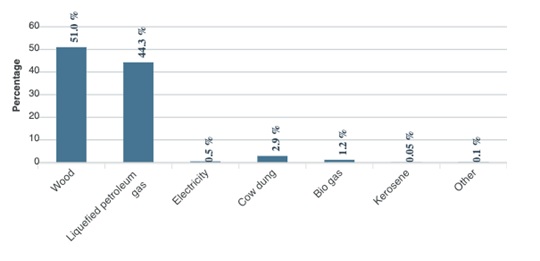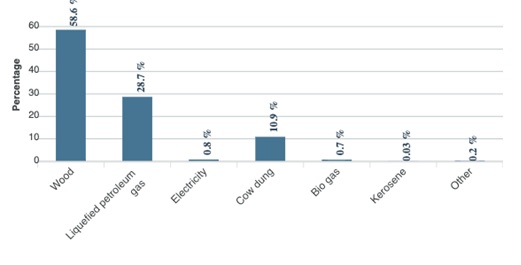VCM Blog

VCM Blog
Is there a need for improved cookstoves (ICS) among rural households of Nepal?
Traditional cook stoves (chulo) depend on solid biomass fuel like firewood, agriculture residue and cattle dung which results in more production of smoke and has direct implications on the environment and public health. The latest census (2021) of Nepal shows that more than 51% of the population still rely on firewood for cooking (figure 1), of which 58.6% of households are in Madhesh Province (figure 2). Generally, in Nepal cooking tasks fall on women and are the part of the population who are exposed to smoke and other harmful fumes due to indoor pollution cause by traditional stoves. Likewise, the biomass consumption is higher in poor communities as they tend to have larger family size (7 people in average).

Figure 1: households by fuel usually used for cooking in Nepal (National Statistics Office, 2021)

Figure 2: households by fuel usually used for cooking in Madhesh province (National Statistics Office, 2021)
The census reflects that approx. 3.2 million population of the country is living in poverty, with 20.27% being under the poverty line (Nepal Living Standards Survey IV, 2022-23), and the majority residing in rural areas. Although the Multidimensional Poverty Index shows that Nepal has been successful in reducing the poverty rate, there are still substantial poor communities that live in rural areas with limited access to infrastructure that cover basic necessities like proper roads and constant grid connection. Most of such households are in Terai region. In those communities, the healthy, abled men opt for overseas labor for employment, leaving behind their families. Women of the household then take on predominantly men roles resulting in them having to shoulder the burden of extra responsibilities on top of their socially defined roles like caregiver, homemaker, etc. They are also exposed to indoor pollution for longer duration due to longer time taken for cooking. WHO (2023) states that 3.2 million people suffer and die prematurely from indoor air pollution, and highlights that this is a gender issue especially in low and middle income countries like Nepal. Additionally, women are responsible for foraging firewood and sourcing other biomass fuels. Taking into account the foraging/fuel gathering and cooking time, they tend to spend majority of their time on these activities. Although, they run the household in the absence of men, important decision-making tasks especially on financial matters, are not handed to them due to the patriarchal construct of the society. This societal norm impedes women from taking actions that prove betterment for her and her family, and is more pertinent in poorer households.
This is where improved cookstoves (ICS) play a vital role in contribution to a cleaner environment and the wellbeing of women in poorer communities. ICS reduce indoor air pollution significantly and decrease greenhouse emission by 2.5 tons of CO2 per stove per year (WWF, 2015). Biomass like firewood is still the main source of fuel for ICS but it takes up less amount of it and produces far less smoke, hence increasing the efficiency and combustion of biomass used. This means that minimal firewood is used which leads to less smoke production, less cooking time and ultimately reduced workload for women. Along with it, the various models of ICS (e.g., fixed or portable, one-pot or two-pot, different tier stoves) give people the options to adopt stoves that are more suitable to their daily needs and lifestyle. Moreover, most of the poorer houses, especially in Terai, are made by bricks and stones with tiles or straw in the roof with a separate area (generally outside of the house) for kitchen. This makes it ideal to set up ICS and other related components like chimney as there’s less need to make drastic changes in the house. The adoption of ICS also gives more autonomy to women as they have more hold over their time and responsibilities. In some poor households, it has been observed that clean cooking methods like LPG and induction stoves are only used during special occasions like festivals and still rely on firewood for cooking and other domestic uses. This can be attributed to the various factors like familiarity with traditional techniques, perception on new cooking techniques, willingness to pay for new technologies, lack of financial support to use new tools, monthly recurring expenses for LPG replacement or electricity bills and so on.
Especially for a country like Nepal, where majority of the population live in poor rural areas and depend on traditional use of firewood, ICS provide households with sustainable options under workable conditions. Low-cost clean cooking methods like ICS not only has environmental benefits, it also has positive social implications as women take less time in collecting firewood and there is less social pressure to carry out household chores. With women having more autonomy over their time, there are more possibilities for them to be involved in various economic activities that can support their family and increase their quality of life. Since ICS is an upgraded and efficient version of traditional stoves, poorer communities will be more open to use it since the fundamentals are similar to the stoves they are familiar with. Hence for long-term usage of ICS, there is a necessity for proper policies and legislation that provide structure and support from government and other external bodies, which subsequently aids in the country’s contribution to climate change mitigation and socio-economic prosperity.
(written by Chetna Gurung, Researcher at SPI Nepal)